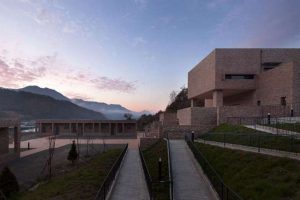
It is natural that many long-lasting traditions of tantric practice include dance as an element of the ritual. Dance is also an element of iconographic art, which is of a piece with the dance and the ritual. It is similar with ritualized sexual activity, something often depicted in tantric Buddhist art, yet less commonly practiced as an enlightenment method. Mental visualization is complementary to the transformative, metabolic, and psycho-physical nature of dance and sex. Visualizations can center on a meditation deity in sexual embrace—sometimes dancing while in sexual embrace.
The symbolic idealization of the genitals—linga and yoni in Hindu tantra; yab yum for sexual embrace in Tibetan iconography—is a worldwide phenomenon. The Virgin Mary hovering in her sky-woven aural egg can be understood as a tantric icon. The Inner Alchemy of Taoists relies on replacing the physical body parts with symbolic activators, inner landscapes, and dynamic mechanisms. Jing, or, generative energy, constitutes the sexual abstraction in a process with vital energy and mental energy. Such ritual acts can also be understood within a tantric framework.
The purpose in these symbols, rituals, and meditation practices is the utter transformation of a physical act into a consciousness elevating experience of mystical wholeness. The body becomes the locus of symbolic action; the body becomes the field of transformed biological consciousness. A visualized deity can replace the physical body as the expressive and effective force. Such techniques, whether in dance or meditation, require a high level of skill and accomplishment.

Dance, being extraordinary—not a mundane way of moving—already begets transformation. The intention to create new patterns of movement requires a full body-mind attention that, too, is beyond normal everyday consciousness. Dance begets, induces, and sustains a purified consciousness with an enlivened, unified, whole-body movement. This movement toward one’s essential nature and self, organized according to a cosmic intelligence in ritual forms, is the action of tantra.
These ideas need to be balanced by those of certain traditional, and very conservative, Hindu Tantric priests, highly respected lineages producing great scholars. They’d contend that the Shiva Lingam symbolizes many things, but an erect human penis it most certainly does not! How coarse and vulgar to imagine that a sculpture of an erect human penis should have any association with an erect human penis! Similarly, there are some scholars and initiated leaders in Buddhism who consider Vajrayana Buddhism a debasement of true Buddhism; and that any suggestion of sexual tantra within Buddhist tantric practices are merely and only artistic, symbolic, and metaphoric. The claim is that enlightenment was never taught as actual sexual tantra, and any suggestion advocating sexual tantra is heresy, dilettantism, fetishism, or fabrication.
However, there has long been a practice of sexual tantra within Vajrayana Buddhism. Differing voices coexist, as always. Taboo has long been associated with tantric practices, divine madness, and the abandonment of customary norms. The shunning by puritanical quarters is part of the characteristic of tantra. Life as a laboratory of consciousness, beyond good and evil, is for the brave. Tantra began in part, as a subversive response to Brahmanical orthodoxy.
Prajwal Vajracharya, a well-known master of Newar Tantric Buddhism, and the world’s foremost exponent of Tantric Buddhist Charya Nritya dance, puts it plainly: “I never use the word tantra because everyone thinks it means sex, and it doesn’t. Don’t do tantra. Do you.”

One understanding of tantra is that it is as old as the mysterious goddess figures found in cave art. Ancient dancing figures, ambiguous to the modern world, continue to embody transformed states of being. From about 600 CE, the earliest date of tantric Buddhist texts, there is some written record of an established undercurrent of consciousness development, particularly in Bengal, Kashmir, and Assam, where tantra developed in opposition to Brahminical religion and ritual. The ancient current of tantra is a cult of ecstasy: cultivated lifestyles, a complex of emotive signs and symbols: art, philosophy, myth, magic, and ritual converge on a vision of a cosmic sexuality—within all nature, within oneself, in union with another, with all others.

Tantra shares some of the nuance of Zen in the concept that while reality and what it looks like are two entirely different things, reality, at the same time, is also exactly what it looks like. Tantra is affirming, not denying. Tantra is a voluptuous way to live through fleeting existence with detachment: offering scaffoldings of technical practices that vanish on the realization of emptiness. Tantra offers a skill set rooted in the senses and in the physical embodiment of virtues and transcendent qualities.

Tantric dances within traditional Buddhism include monastic cham dance performed by Vajrayana monks and, increasingly, nuns. Nepalese Newar Charya Nritya, is also a Vajrayana Buddhist ritual form. Charya is a tantric dance of complete transformation into a meditation deity. Other fundamental characteristics of Buddhist tantric dances are the use of mantra, mudra, mandala, and meditation. Each of these elements crosses psychological and physical barriers, uniting body and mind, conscious and unconscious; effecting the transformation of the body and the mind; producing an awareness of the essential emptiness of all phenomena. A new body is formed to be a vessel of the purified mind.
Dance is how such enlightened beings move.

See more
Related features from BDG
Monastic Dance Courtyards in Ladakh and Zanskar
Nabji, Part One: Bearing Relics
Dance Survival
















